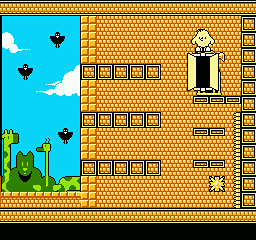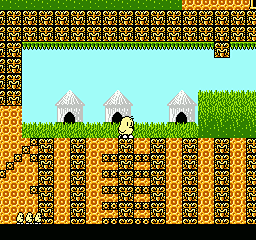
NewZealand Story (1991-)
Developer: Software Creations | Taito
Publisher: Taito
Genre: Platform
New Zealand Story for the NES was developed by Software Creations and published by Taito, with its release taking place in 1990. The game is a home console adaptation of Taito’s successful arcade title, which had gained popularity for its colorful graphics and engaging platforming. Inspired by classic side-scrolling adventures and the arcade scene of the late 1980s, the game follows Tiki, a small kiwi bird, on a quest to rescue his kidnapped friends from a mysterious villain. Its combination of character-driven storytelling and challenging gameplay made it a standout among NES platformers of the era.
Gameplay in New Zealand Story centers on side-scrolling platform action. Players control Tiki through a variety of levels filled with enemies, traps, and environmental hazards, using items such as rocks or eggs to defeat foes. Each stage includes unique challenges, secret areas, and bonus opportunities, encouraging exploration and mastery. The game balances simple controls with increasing difficulty, providing a rewarding experience for both new players and those seeking a challenge. Timing, precision, and strategy are key to progressing through the diverse and often intricate stages.
The NES soundtrack mirrors the energetic and playful tone of the arcade original. Upbeat and melodic compositions accompany each level, enhancing the sense of adventure and pace. Sound effects, including Tiki’s attacks, jumps, and interactions with enemies, provide clear audio feedback that complements the on-screen action. The visual design preserves much of the arcade’s charm, featuring clear, colorful sprites and distinctive environments that help maintain the appeal of the game across its multiple stages.
While New Zealand Story did not have a prequel, it inspired sequels and ports on various platforms, expanding the franchise beyond the NES. The NES version was promoted through video game magazines and advertisements that highlighted its vibrant graphics, engaging platforming, and cooperative gameplay elements. Reception at the time was generally positive, with reviewers praising its combination of charm, strategy, and challenge, though some noted that certain arcade mechanics were simplified. Overall, it remains a notable example of NES platforming and a successful adaptation of a popular arcade title.
Images from MobyGames
Buy NewZealand Story
Click one of the Ebay or Amazon buttons below to check the latest prices and purchase NewZealand Story for the Nintendo Entertainment System.

Related Searches
NewZealand Story NES Download
NewZealand Story is available to purchase and download from a range of vendors. Always shop around...
NewZealand Story NES Manual
Various repositories around the internet have scanned and archived a range of retro manuals. Search now to.....
NewZealand Story NES Rom
We don't host or link to rom sites for this game. However, there are many sites out there that may be...
NewZealand Story NES Walkthrough
Many sites - particularly YouTube - host a range of walkthrough videos to guide you in your quest to get...
NewZealand Story NES Cheats
There are various sites out there that can offer cheat codes for games. Search now to find all available...
NewZealand Story NES Controls
This information can often be obtained through the user manual. Alternatively there are many sites out there...
NewZealand Story NES Release Date
The initial release date for NewZealand Story is stated as March 1991. Other ports of the game may..
NewZealand Story NES Review
There are many sites out there that have collated and documented historic reviews of this game. Search now...
NewZealand Story Famicom
As a Nintendo Entertainment System release, this game was also likely also available on the Famicom. This....
NewZealand Story NES Speedrun
There is now a community of competitive speedrunners who will try and gain the fastest possible time on their....








